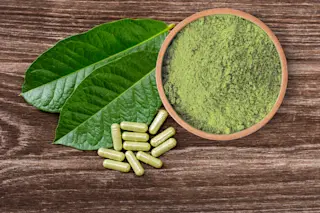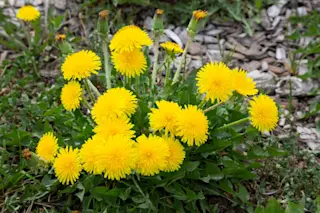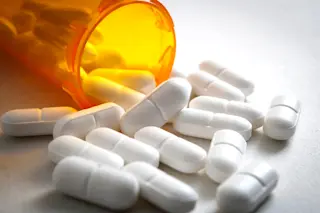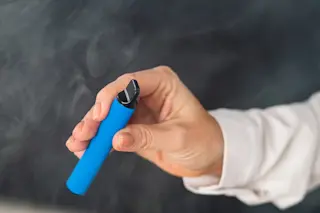In the late 1990s, years before powdered kratom leaves became a commodity at smoke shops throughout the Western world, Duncan Macrae went searching for Mitragyna speciosa in the jungles of Borneo. The enigmatic Scot had lived in Bali for more than a decade. In the 1980s, he discovered a new species of monitor lizard and helped create the Bali reptile park. Now his attention was diverted to a new adventure. A few lines in an obscure anthropological article had captured his imagination. He was determined to seek out a tropical evergreen tree that Thai people had long used to ameliorate the symptoms of opium withdrawal.
“There was very little on the internet back then about what the tree actually looked like,” he said. “But we found a few generic pictures and printed them out.
Macrae flew into Pontianak and started showing the pictures to locals in the hope of chasing down a lead. By word of mouth, he ended up further and further from the city, until, finally, he found what he was looking for along the banks of a foliage-choked river.
“It was unbelievable. There were hundreds and hundreds of these kratom trees,” he said.
He enlisted local help to harvest and dry samples. Then he flew back to Bali where he experimented with consuming the dried plant by various methods. Mixing the astringent leaves into a milkshake seemed to be the most palatable option.
“When I started to feel the effects, it was like, ‘wow.’ This is something very pleasant, very different and I think this is going to be very popular.”
Macrae sent samples to ethnobotanical suppliers, and the agreeable effects of the substance seemed to market themselves. Just a few years later, in 2001, he exported seven tons of the plant to a warehouse in the U.S. in order to keep up with demand. In the two decades since, the kratom market has expanded to include thousands of vendors and millions of consumers all over the world.
In 2019, an estimated 2 million Americans used kratom. Consumers report using the plant to self-medicate for chronic pain, anxiety, depression and opioid withdrawal. The two primary psychoactive alkaloids found in the leaf, mitragynine and 7-hydroxymitragynine, act on opioid receptors in the brain, but the associated risks seem to be far less severe than those of opium-derived compounds. As the opioid epidemic has steadily worsened, more and more addicts have turned to kratom as a home-remedy for overcoming their vice.
A Misinformation Problem
In 2018, the FDA sent cease and desist letters to a number of U.S. kratom vendors that it claimed were “selling kratom and doing so with deceptive medical claims for which there’s no reliable scientific proof to support their use.” Because the plant is not an FDA-approved dietary supplement, it is illegal for a U.S. company to market kratom for consumption or to make any “structure function claims” about the plant’s supposed health benefits.
Despite this, many companies continue to toe the line when it comes to marketing kratom products. For instance, the description for “Borneo Reserve Red Vein Kratom Powder” on KratomUSA.com makes the dubious statement that the product “promotes a calming lifestyle and also promotes an opiate free lifestyle.”
In March, Canadian healthcare researchers published a paper that assessed the quality of consumer health information that was provided on kratom vendors’ websites. They found that claims were often poorly cited, relied on anecdotal evidence and misrepresented scientific research. Jeremy Ng, the primary author of the paper, says that vendors tend to provide “a one-sided perspective of kratom” that focuses on potential benefits and neglects potential risks.
But, kratom vendors aren’t the only ones who have been accused of misrepresenting scientific research. When the FDA first recommended designating kratom as a schedule I drug in 2016, they cited 44 deaths that they claimed were “associated with the use of kratom.” Closer inspection revealed that, of the 44 deaths, 43 involved additional substances. In one of the cases, the victim had actually died due to a gunshot wound to the chest. American Kratom Association (AKA) consultant Jane Babin accused the FDA of executing “a strategy of manipulating, obscuring, and ignoring science in its inexplicable zeal to impede public access to the natural botanical kratom.”
While the FDA advocates an outright ban on kratom, the AKA is in favor of a regulatory approach. The organization has successfully lobbied for a version of the Kratom Consumer Protection Act in five separate states. The act establishes strict rules for the purity and labeling of kratom products and bans sales to minors.
The Research: Mortality
A 2019 study in Preventative Medicine estimated that “the risk of overdose death is >1000 times greater for opioids than for kratom.” While most morphine-like opiate overdoses are fatal due to the drugs’ respiratory depressing effects, kratom seems to have little effect on respiration.
Of course, many drugs that are relatively benign on their own become dangerous when mixed with other substances. The mortality data suggests that the alkaloids in kratom may create a lethal cocktail when paired with other compounds.
Because kratom is usually sold as a “botanical specimen,” the industry is mostly self-regulated. This means that one major health risk of consuming kratom products is contamination. In 2018, 50 Americans were hospitalized after eating kratom that was contaminated with salmonella. A second source of contamination was discovered the next year — the WWII era grinding machines that were used by many Indonesian kratom growers to powder the leaf. The FDA found unsafe levels of nickel and lead in a number of kratom products.
A statement from the administration read, “based on these test results, the typical long-term kratom user could potentially develop heavy metal poisoning.”
In an attempt to preempt other instances of contamination, the AKA has developed a “Good Manufacturing Practices” program. Participating vendors go through an independent third-party audit and are awarded with a listing on the AKA’s website.
The Research: Is Kratom Addictive?
Even kratom’s advocates will often agree that the plant is somewhat addictive. The disagreement tends to be on the severity: is it more like coffee or heroin? A 2020 survey of 2,798 American Kratom users by Johns Hopkins Medicine found that less than 3% of respondents met the criteria for moderate or severe kratom use disorder.
Even so, for users in that 3 percent, it can be an arduous habit to kick. Jessie Huang, a 29-year old ad specialist at Google, developed a kratom addiction after surviving a physical assault that left her with PTSD.
“I used kratom to be able to work — to, kind of, numb the intrusive thoughts and the intrusive memories that I was having,” she said.
Two years later, Huang had tried quitting multiple times without success. What had started out as a solution, became an even bigger roadblock in her life.
“I was taking so much that I was in a fog all day,” she said. “It made me really nauseous: If I ate while drinking it I would throw up. Time and time again, I would choose kratom over food.”
Huang was eventually able to stop taking kratom, but only after treatment at a rehab facility. During detox, she took suboxone, a prescription drug that is commonly used to treat opiate addiction.
Kratom’s physiologically addictive properties seem to stem from the alkaloid 7-hydroxymitragynine. In one study by Hemby et al., rats repeatedly self-administered this compound, while they refrained from self-administering kratom’s most abundant alkaloid, mitragynine.
This information is discouraging for the plant’s proponents, but it also suggests that an extract of specific alkaloids may impart some of the benefits of kratom without the risks. Macrae’s company, Kratom.com, is poised to capture this market — it recently produced the first-ever line of mitragynine extracts.
The Research: Treating Opiate Addiction
In the Hemby et al. study, the authors allowed rats to self administer morphine for a period of time. Then they substituted the morphine for 7-hydroxymitragynine and mitragynine respectively. When the rats went back on morphine, the ones that had been given mitragynine self-administered significantly less of the opiate than they had before.
Anecdotal evidence from the Johns Hopkins survey points to a similar benefit in humans. Thirty-five percent of respondents who reported using kratom to treat opioid dependence said that they had been able to stay away from opioids for more than a year.
One piece is still missing: clinical trials on human subjects. In 2019 the House Appropriations Committee directed the Agency for Healthcare Research and Quality to invest in “research which will lead to clinical trials in geographic regions which are among the hardest hit by the opioid crisis,” but these trials have yet to come to fruition. Macrae says that researchers are engaged in clinical trials at an American university, but this too is unconfirmed.
For now, kratom will remain a DIY medicine for those searching for an option outside of the healthcare system. But, like psilocybin or cannabis, kratom may see a surge in research interest if the numbers of its advocates continue to grow.















